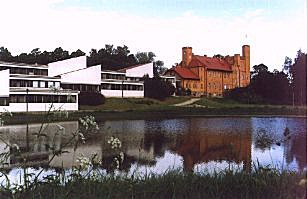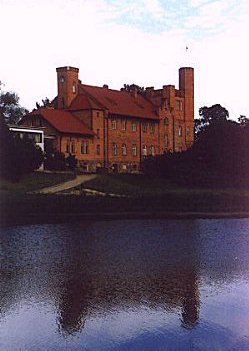Special in Deutsch bitte hier klicken
|
|
|

You can hear Urmas Sisask playing his music live in Jaeneda. He gives concerts in his planetarium on request. Please contact edition 49 for further information (email edition 49). Don't miss this incredible European cultural event! |

In this castle situated in Estonia, you can enjoy concerts with Urmas Sisask playing his own music, mainly his "Starry Sky Cycle." Don't miss this incredible European cultural event! |
Das kulturelle Ereignis in Estland
|
|
|
Das einzige musikalische Observatorium der Welt- wollen Sie wissen, wo es liegt? 75 Kiilometer von
von Tallinn, Estlands Hauptstadt. Wollen Sie dort hin? Kein Problem! Ein Hotel mit 50 Zimmern erwartet Sie inmitten von Wäldern und Seen in der äußerst schönen und erfrischenden nordischen Natur. Im Sommer keine Zeit? Macht nichts, im Winter ist es noch schöner. Sie werden nie die estnischen Ski-Langlaufloipen vergessen. Und die Zeit zwischen Konzertseminaren im Observatorium und Skifahren oder Wandern im Sommer können Sie nutzen, verschiedenen Beschäftigungen nachzugehen, weil in
Jäneda...
1913-15 baute ein Hausherr namens Hans von Benckendorff das Herrenhaus. Sechzig Jahre später wurde ein neues, modernes Gebäude hinzugefügt. So entstand das Jäneda Ausbildungs- und Beratungszentrum. Während an einem Ende junge Studenten ihre höhere Schule und Agrar-ökonomische Berufe erlernen, wird am anderen Ende, im alten Herrenhaus das sichtbare Universum jedem Interessierten vorgestellt. Ein gefeierter junger Komponist von 35 Jahren, Urmas
Sisask, kann Ihnen Erklärungen geben über die Musik, die von sicht- und unsichtbaren Sternen und Planeten ausgeht. Das ist Musik, die Harmonie des Universums!
Es waren vier Freunde, die 1993 die Estnische Gesellschaft für Astro-Musik
gründeten: Urmas Sisask , Komponist; Mikk Sarv, Ethnologe; Einar
Laigna, Priester und Theologe; und Peep Kalv, Astronom. Diese Gesellschaft befindet sich im Turm des Herrenhauses. Sie suchen ein besseres und tieferes Verständnis des Universums in seinen astronomischen, kosmologischen, theologischen und ethnologischen Aspekten zu erlangen. Am 20. Juli 1994 gab es eine größere kosmische Katastrophe, als der Shoemaker-Levi 9 Komet und Jupiter kollidierten. Während das größte von 21 Teilstücken auf die Planetenoberfläche fiel, feierte die Estnische Gesellschaft der Astro-Musik ihre eigene "Katastrophe" - das erste und einzige musikalische Observatorium der Welt wurde im Schloßturm von Jäneda gegründet.
Seit dieser Zeit wurden schon 84 Konzert-Vorlesungen gehalten, und das Interesse wächst weiterhin.
Basierend auf einer fünfjährigen Erforschung der Grundtheorie der Harmonielehre des Universums
baut Urmas Sisask nun die Tastatur des Universums.
Es wird später auch als Mittel für die Vorlesungen benutzt, vorgesehen mit den besten kosmischen Fotos des sichtbaren Universums und Erklärungen sowohl in estnischeer als auch in englischer Sprache. "Die zukünftigen Pläne beinhalten Seminare und Astronomie-Camps, um den Kreis der Astro-Musiker zu erweitern", sagt
Sisask.
Das gegenwärtige Jahr 1996 hat dem muskalischen Observatorium ein höchst modernes Teleskop mit einem Steuerpult, das automatisch 64000 kosmische Objekte auffindet, beschert. Aber mehr noch, seit dem 16. Mai 1996 hat Estland sein eigenes Planetarium. Hausgemacht, aber doch ein Planetarium, dessen Urheber wieder einmal Urmas Sisask ist. Er kann Ihnen die Geschichte des Baus des Planetariums erzählen, angefangen von den kleinen, mit Phosphor bedeckten Sternchen. Diese kleinen Dinger fand er neben künstlicher Misthaufen in einem Scherzartikelladen in Stockholm. Zum Bau des Planetariums erstand er als erstes 24 Flaschen Long Drink (damals Gin Tonic in Flaschen, fertig gemixt. Anmerkung des Übersetzers), eine große Leiter, um an die drei Meter hohe Decke heranzukommen, und etwas Klebstoff. Das war's - nachdem er den "Himmel" in 24 Abschnitte geteilt hatte, kletterte er 2000 (zweitausend) mal die Leiter herauf und herunter, und jeder mit Sternen gefüllte Abschnitt gab ihm die Berechtigung zum Trinken einer Flasche Long Drink. Nach 14 Tagen und 14 Nächten waren die Flaschen leer ....